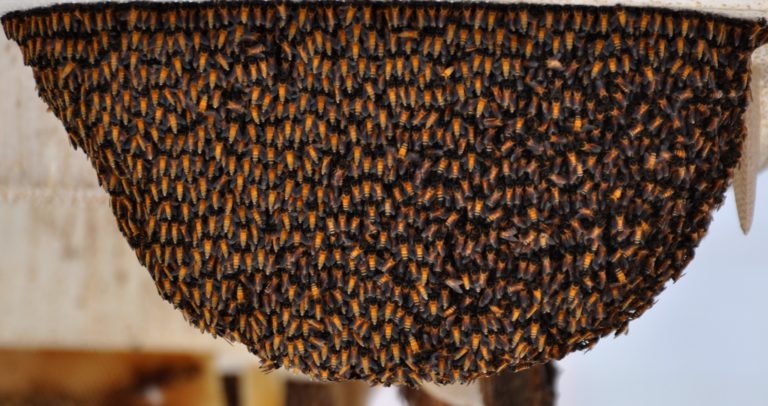The giant honeybee is native to south and southeast Asia, especially in the forest areas of Terai in Nepal. These bees build nests a few metres under overhanging cliffs, where they are often exposed to predators, particularly the Asian hornet.

The giant honeybee is the world’s largest honey bee. Single adults can measure up to 3.0 cm in length. It is highly adapted to its highland habitat in behaviour where it tends to construct exposed nests under cliffs. Picture: Flickr Commons/ P.L. Tandon
Because of their predatory exposure, these bees tend to have an aggressive temperament, quickly mobilising a swarm of defenders to repel any birds or mammals. What is particularly interesting, is how they defend themselves against their main predators – wasps and hornets.
The Asian giant hornet, for example, is a notorious predator for honeybees, where the queen hornet can grow up to 5cm long and destroy a hive in minutes by decapitating bees. This hornet kills up to 50 people a year in the Japan with its painful and venomous sting, but the giant honeybees have developed a few ways to ward them off.
One strategy the bees have adopted is termed “heat-balling”, where a gang of bees descend on an intruding wasp or hornet, vibrating their wing muscles and raising their body temperature to 45°C, which is lethal to wasps. The wasps essentially raise their temperature to cook the intruder.
Another interesting strategy they have developed is more avoidant and involves the giant honeybee doing a “Mexican wave” where hundreds of individual bees flip their abdomens upwards in a split second, forming these wave-like patterns.
View this post on Instagram
This shimmering wave is ineffective in stopping larger predators such as birds, but field observations revealed that this phenomenon is effective in deterring wasps and hornets. ‘When the hornets were closer than the mean hovering distance, they withdrew from the nest in the course of shimmering,’ an article published in the Public Library of Science read.
Another interesting observation is that when these worker bees raise their abdomens, they release a pheromone called Nasonov, which sends a signal to other bees to stay together and not break rank.
ALSO READ: The perfect springtime sighting? A caracal in the wildflowers


















